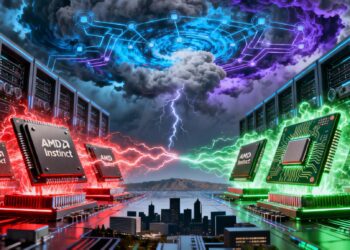Blockchain Will Drive the Agent-to-Agent AI Marketplace Boom
The future of artificial intelligence isn’t just about smarter algorithms—it’s about creating autonomous digital workers that can trade, collaborate, and transact with each other. And blockchain technology is emerging as the critical infrastructure to make this vision a reality.
The Rise of Autonomous AI Agents
AI agents are everywhere now. These aren’t your grandfather’s chatbots. We’re talking about sophisticated software systems that use artificial intelligence to pursue goals and complete tasks on your behalf—without you having to micromanage every step.
Think about it. Your calendar manager powered by GPT that schedules meetings based on your preferences. Trading bots that execute complex financial strategies while you sleep. Customer service agents that resolve issues without human intervention. The use cases are exploding.
But here’s the thing: as these agents become more capable, they need infrastructure that lets them work together. They need to communicate. Collaborate. Trade services. And most importantly, they need to do all this autonomously.
That’s where the real challenge begins.
The Centralization Problem
Big tech companies see the opportunity. Google and AWS are building early marketplaces and commerce protocols for AI agents. Sounds great, right?
Not so fast.
David Minarsch from Olas raises a critical question: will these tech giants aim to extract massive rents through walled gardens once more? History suggests they might. We’ve seen this movie before with app stores, cloud services, and social media platforms.
The problem with centralized marketplaces is fundamental. Agents must wait for human verification. They rely on closed APIs. They operate in environments where transparency is optional—if it exists at all.
To act autonomously and at scale, agents can’t be boxed into closed ecosystems. They need freedom, an open infrastructure and blockchain.
What Makes an Agent Truly Autonomous?
Autonomy isn’t just about intelligence. Sure, AI agents are getting smarter almost daily with new models and architectures. But intelligence alone doesn’t equal autonomy.
Here’s what true autonomy requires:
Decision-making capability. Agents need to anticipate needs, adapt to changing conditions, and coordinate with other systems in real time—without constant human input.
Access to resources. Without resources, an AI agent has little means to enact change in the real world. They need to control assets.
Self-custody. Agents must be able to hold and manage their own resources securely.
This is where blockchain becomes essential. Programmable, permissionless, and composable blockchains provide the ideal substrate for agents to access resources and self-custody their assets.
Two Visions of the Future
Picture two scenarios.
Scenario One: AI agents operate within a Web 2 platform like AWS or Google. They exist within limited parameters set by these platforms. It’s essentially a closed, permissioned environment. Agents can only do what the platform allows. They’re trapped in a digital cage.
Scenario Two: A decentralized marketplace spanning many blockchain ecosystems. Developers can compose different sets of environments and parameters. The scope available to AI agents is unlimited. It’s accessible globally. It can evolve over time.
One scenario looks like a toy marketplace. The other is an actual global economy.
The difference is stark. And it matters.
Why Centralized Marketplaces Fall Short
AWS recently announced an agent-to-agent marketplace aimed at addressing growing demand for ready-made agents. But their approach inherits the same inefficiencies that have plagued siloed systems for years.
The limitations are clear:
- Agents must wait for human verification
- They rely on closed APIs
- They operate where transparency is optional
- Platform risks are unavoidable
- Fees are opaque
- It’s impossible to verify what actions were taken and why
These aren’t minor inconveniences. They’re fundamental barriers to true agent autonomy.
How Blockchain Enables True Agent Autonomy
Blockchain technology offers something different. Something revolutionary.
An open ecosystem allows agents to act on behalf of users, coordinate with other agents, and operate across services without permissioned barriers. No gatekeepers. No arbitrary restrictions.
Blockchains already provide the key tools needed:
Smart contracts allow agents to perform tasks automatically, with rules embedded in code. No intermediaries required.
Stablecoins and tokens enable instant, global value transfers without payment friction. Agents can transact in milliseconds.
Smart accounts like Safe allow users to restrict agents in their activity and scope through guards. You can set spending limits. Require multi-signatures for approvals. Restrict agents to whitelisted protocols.
This combination is powerful. Agents can behave expansively while being contained within risk parameters defined by the end user.
The Transparency Advantage
Here’s something centralized systems can’t match: transparency.
Blockchain provides the transparency needed so users can audit agent decisions—even when they aren’t directly involved. Every transaction is recorded. Every action is traceable. Trust is built into the system.
But this doesn’t mean all agent-to-agent interactions need to happen onchain. AI agents can use offchain APIs with access constraints defined and payments executed onchain. It’s the best of both worlds.
Decentralized infrastructure gives agents the tools to operate more freely and efficiently than closed systems allow.
It’s Already Happening
While centralized players are still refining their agent strategies, blockchain is already enabling early forms of agent-to-agent interaction.
Onchain agents are exhibiting advanced behavior right now. They’re purchasing predictions and data from other agents. As more open frameworks emerge, developers are building agents that can access services, make payments, and even subscribe to other agents—all without human involvement.
The next step is already being implemented: monetization.
With open marketplaces, people and businesses can rent agents, earn from specialized ones, and build new services that plug directly into this agent economy. Customization of payment models—subscription, one-off payments, or bundled packages—will facilitate different user needs.
This unlocks an entirely new model of economic participation.
Learning from DeFi
We’ve seen this pattern before. Decentralized Finance (DeFi) proved that open, composable systems work.
In DeFi, bots automate lending strategies, manage positions, and rebalance portfolios—sometimes better than any human could. These “DeFi legos” demonstrated the power of composability.
Now, that same approach is being applied as “agent legos” across sectors. Logistics. Gaming. Customer support. Healthcare. Education. The possibilities are endless.
The Fragmentation Problem
Without open systems, fragmentation breaks the promise of seamless AI support.
An agent can easily complete tasks if it stays within an individual ecosystem—like coordinating between different Google apps. But what happens when third-party platforms are necessary?
When you need to coordinate across social media, travel booking, financial services, and more, closed systems fail. Each platform has its own API. Its own rules. Its own restrictions.
An open onchain marketplace solves this. It allows agents to programmatically acquire the various services and goods they need to complete a user’s request—regardless of which platforms are involved.
Real-World Applications Emerging
The agent economy is growing fast. And real applications are emerging across industries.
Finance: Trading agents that execute complex strategies across multiple exchanges simultaneously.
Logistics: Coordination agents that optimize supply chains by communicating with warehouse systems, shipping providers, and inventory management tools.
Gaming: NPCs (non-player characters) that can trade items, form alliances, and make strategic decisions autonomously.
Customer Support: Service agents that can access multiple systems to resolve customer issues without human escalation.
These aren’t hypothetical use cases. They’re happening now.
The Economic Opportunity
The economic implications are staggering.
When agents handle repetitive, time-intensive tasks and parallelize what previously had to be done in sequence, they expand our productive capacity as humans. They free people to engage in work that demands creativity, judgment, composition, and meaningful connection.
This isn’t science fiction. Humanity has been here before. The arrival of corporations allowed entrepreneurs to create entirely new products and levels of wealth previously unthought of. AI agents have the potential to bring that capability to everyone.
Not just corporations. Not just the wealthy. Everyone.
The Intelligence Factor
On the intelligence side, truly autonomous decision-making requires AI agent infrastructure that is open source and transparent.
OpenAI’s recent open-source release is a good step. Chinese labs like DeepSeek, Moonshot AI, and Alibaba have moved even quicker with their own open-source models.
But autonomy isn’t purely tied to intelligence and decision-making. Without resources, an AI agent has little means to enact change in the real world.
That’s why blockchain matters so much.
Why This Distinction Matters Now
We’re at a critical juncture. What we build now will shape how the agent economy functions and for whom it works.
If we rely solely on centralized systems, we risk creating another generation of AI tools that feel useful but ultimately serve the platform, not the person. We’ve seen this pattern with social media. With app stores. With cloud services.
Blockchain changes that dynamic fundamentally.
It enables systems where agents act on your behalf, earn on your ideas, and plug into a broader, open marketplace. You maintain control, capture the value and set the parameters.
The Path Forward
The agent economy is growing fast. Adoption is accelerating. Investment is pouring in.
But the infrastructure we choose will determine whether this technology empowers individuals or enriches platforms.
If we want agents that collaborate, transact, and evolve without constraint, then the future of agent-to-agent marketplaces must live onchain. There’s no other way to achieve true autonomy at scale.
The technology exists. The use cases are proven. The economic model is clear.
Now it’s about making the right architectural choices. Choosing open over closed. Permissionless over permissioned. Transparent over opaque.
The agent-to-agent AI marketplace boom is coming. Blockchain will drive it. The only question is whether we’ll build it right.
Sources
- Blockchain Will Drive the Agent-to-Agent AI Marketplace Boom – CoinDesk
- AI Agents Thrive in Decentralized Marketplaces Powered by Blockchain – CoinCentral









